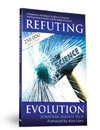
|
Refuting Evolution
by Dr Jonathan Sarfati
Navigation
Study Guide
Table of Contents
Chapter 1
Facts & Bias
Chapter 2
Variation and Natural Selection Versus Evolution
Chapter 3
The Links Are Missing
Chapter 4
Bird Evolution?
Chapter 5
Whale Evolution?
Chapter 6
Humans: Images of God or Advanced Apes?
Chapter 7
Astronomy
Chapter 8
How Old Is the Earth?
Chapter 9
Is the Design Explanation Legitimate?
Chapter 10
Conclusion
Lesson 3
Chapter 3: The Links Are Missing
Supplemental material:
Discussion questions:
- What do the comments by E.O. Wilson and W.B. Provine about an alleged ‘missing link’ between wasps and ants again reveal about the nature of ‘evidence’?
- List some reasons evolutionists give for the apparent lack of ‘transitional’ fossils.
- What are the requirements for fossilization?
- Outline the evolutionary story behind the transition from fish to amphibian. List some of the problems with this story.
- What are the alleged ‘transitional forms’ between amphibians and reptiles? Describe the problems with this idea.
- What animals are listed by evolutionists as ‘transitional’ between reptiles and mammals? Outline the overall problems with the idea that reptiles eventually gave rise to mammals.
-
Why is it not advisable to say, ‘There are no transitional fossils’?
See: - What is a ‘living fossil’? What is the significance of a ‘living fossil’?

Answers
- Evidence can be interpreted in different ways, based on one's worldview.
- See pages 51-53.
- A well-preserved fossil generally requires rapid burial, and cementing agents to harden the fossil quickly. This is usually caused by a catastrophic condition.
- Formulate your own response—see pages 53-54. See also Q&A: Fossils.
- Formulate your own response—see pages 54. See also Q&A: Fossils.
- Formulate your own response—see pages 54-55. See also Q&A: Fossils.
- See Arguments creationists should not use.
- Living fossils are animals or plants that are also found in the fossil record. Living fossils show that things stay basically the same over time. See Q&A: Living Fossils.

Readers’ comments
Comments are automatically closed 14 days after publication.